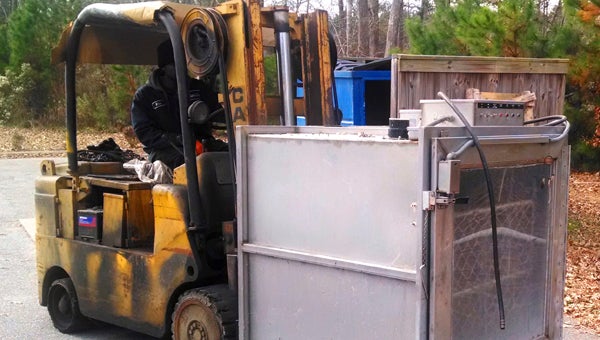THE HUMANE WAY: County Animal Control scraps gas chamber
Published 6:00 pm Saturday, December 6, 2014

DOTTIE WALKER | CONTRIBUTED
IN THE WINDOW: Dogs and cats featured in Pets of the Week are only a small fraction of those in need of adoption at the Betsy Bailey Nelson Animal Control Facility. Overcrowding often forces animal control staff to make room for incoming animals — overpopulation most often caused by unsprayed or unneutered animals — by euthanizing those that haven’t been adopted or rescued. For more information on these Pets of the Week see page
Beaufort County Animal Control dismantled its gas chamber Friday, a move that insures all animals euthanized at the shelter are done so using the more humane injection method.
“It’s a big change — and a good change,” said Animal Control Chief Todd Taylor.
Gas chambers used for euthanizing animals have been banned in 21 states and animal rights organizations believe gassing is inhumane — the injection method is only humane option. The local shelter has long been criticized for its use of the gas chamber, which is one reason Taylor started the process of making the switch two years ago.
“With injection you have more detailed process; a more hands-on process,” Taylor said. “There’s a lot involved in just having that process on site.”
That process involves two injections: the first, strong tranquilizers that anesthetize the animal; the second, pentobarbital, which ends the animal’s life by cardiac arrest. In order to perform injections, the shelter’s fulltime employees went through certification with the North Carolina Department of Agriculture; a certification that must be renewed every five years. The shelter also had to apply for a license to possess controlled substances from the DEA.

BEAUFORT COUNTY ANIMAL CONTROL | CONTRIBUTED
DISMANTLED: The gas chamber at the Betsy Bailey Nelson Animal Control Facility was removed from operation Friday. Animals at the facility will no longer be euthanized by gas, but through the more humane injection method.
While removing the animal shelter’s gas chamber is new, animal control staff using the injection method isn’t. For the past several years, they’ve used it in up to 80 percent of its cases — gas chamber use has been relegated to putting down dangerous animals and overpopulations of feral cats, Taylor said.
Overpopulation has been an ongoing problem for the shelter because of the number of unsprayed and unneutered animals in Beaufort County. It’s led the county and the HSBC to join forces to combat the problem with a spay/neuter program that offsets the costs of the procedures for pet owners, or those who don’t claim a pet, but nevertheless feed stray animals.
“The tragedy is that we need to be putting so many animals to sleep. It would be nice if the only animals we have to put down are animals that aren’t adoptable,” said Pamlico Animal Hospital owner and Humane Society of Beaufort County President Marty Poffenberger, adding that much of the problem is a lack of responsibility on the part of pet owners that leads to the necessity of euthanizing so many animals.
Nearly 1,300 animals have been adopted or rescued from the Beaufort County animal shelter in 2014 — a success due to the effort and teamwork of volunteers and animal control staff. However, even as adoption rates continue to rise from year to year, the number of animals that are put down is startling.
“This calendar year, from January 1 to December 3, it’s 878, which is low, let me tell you,” Taylor said. “When I first started (working here) we were euthanizing 2,000 a year. Our adoption rate is definitely saving us.”
Taylor calls the transition to injection-only euthanasia bittersweet: ultimately, it places less stress on many of the animals being put down, but, in turn, transfers that stress to the animal control staff doing the procedure. Because of this, part of their certification requires compassion fatigue training, an effort to offset the emotional trauma of doing their job.
“Basically it’s a nice word for PTSD,” Taylor said. “A person who has to do our job — people from outside can’t understand the job. It’s a mental strain. I think people think we’re heartless, but actually it’s the total opposite. You end up getting PTSD symptoms.”
Case in point regarding the emotional toll of the job was an October outbreak of parvovirus among dogs housed at the shelter. Parvo is a highly contagious, life-threatening disease and in order to contain its spread, animal control put down 28 dogs in a single day — nearly all of the shelter’s dog population. The only dogs not euthanized were those housed in separate areas of the facility. The act was devastating for staff and volunteers, according to Taylor and several volunteers who cared for the dogs. For several days after, staff decontaminated the facility and reestablished proper cleaning techniques among shelter and staff.
“We got everybody doing the same cleaning procedure — just taking action, knowing procedure, “ Taylor said.
A second instance of parvo occurred in late November, but this time the death toll was kept to a minimum.
Taylor said the current outlook at the shelter is good: population has been relatively low and many animals are in the pre-adoption process. But with the county’s consistent overpopulation problem that will change, and more animals will be put down.
“The only time we do it is when we’re full and we have no choice but to make space,” Taylor said. “You get to that point when you run out of options and we’ve got to make space.”





